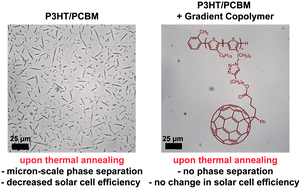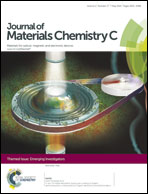π-Conjugated gradient copolymers suppress phase separation and improve stability in bulk heterojunction solar cells†
Abstract
Gradient sequence copolymers of 3-hexylthiophene (90 mol%) and 3-(6-bromohexyl)thiophene (10 mol%) were synthesized by catalyst transfer polycondensation. Post-polymerization conversion of the side-chain bromides into azides and subsequent Cu-catalyzed azide–alkyne cycloaddition installed C60-functional groups. Comparing blends of poly(3-hexylthiophene) (P3HT) and phenyl-C61-butyric acid methyl ester (PCBM) with and without the gradient copolymer additive revealed that, when the gradient copolymer was present, micron-scale phase separation was not observed even after prolonged thermal annealing times. In addition, the PCBM was still able to quench the P3HT emission after thermal annealing, indicating that the donor–acceptor interfacial area is maintained. Together, these data suggest that the gradient copolymers are an effective compatibilizer for P3HT/PCBM physical blends. This stabilized film morphology led to stable power conversion efficiencies (PCE) of the corresponding bulk heterojunction solar cells even upon extended thermal annealing. Nevertheless, the short circuit current and fill factor were reduced when the gradient copolymer was present, leading to a lower PCE. Overall, these gradient copolymer additives represent a promising tool for inhibiting micron-scale phase separation and producing robust polymer/fullerene-based solar cells.

- This article is part of the themed collection: Emerging Investigators

 Please wait while we load your content...
Please wait while we load your content...